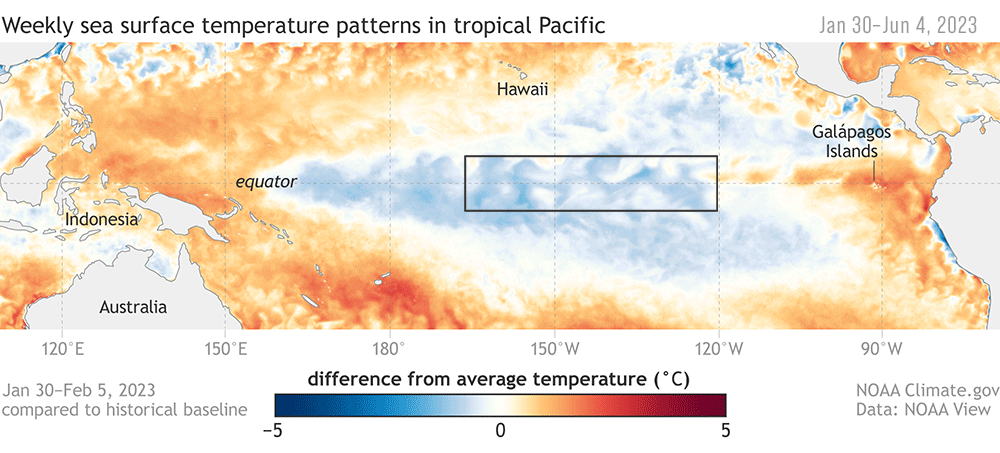The US National Oceanic and Atmospheric Administration (NOAA)’s Climate Prediction Center has officially declared an El Niño, with all the likelihood of extreme weather that involves. The event comes as no surprise, after months of warnings by the World Meteorological Organization and national climate institutes, but the timing of the announcement reflects the fact the event has started at the earlier end of predictions and is looking like a strong one.
El Niño (meaning “the boy child”) gets its name from the fact that one of its defining features, warm waters off the west coast of South America, can be most intense around Christmas. This year, however, the waters off Peru are already far above normal in June. That’s bad news for the fishing industry there, as the vast stocks of anchovies that rely on cold water upwellings can be expected to crash.
Following the recognition that the effects are much more widespread, El Niños are now measured using other factors, particularly the air pressure gradient between the east and west Pacific.

The streak of red off the coast of South America is a key indicator of El Niño. Usually strongest around Christmas, it’s hard to imagine how much more intense it could get.
Image Credit: NOAA climate.gov
Some parts of the world are already experiencing typical El Niño conditions, but the NOAA thinks the effects for Americans will be delayed. “El Niño’s influence on the US is weak during the summer and more pronounced starting in the late fall through spring,” the statement reads. “By winter there is an 84 percent chance of greater than a moderate strength El Niño and a 56 percent chance of a strong El Niño developing.”
In North America, the most notable El Niño features are increased rain and snow in Southern California and along the Gulf Coast and drier-than-usual conditions in the Pacific North-West and parts of the Midwest. The statement notes these patterns are statistically likely to happen in an El Niño year, but there are exceptions where during El Niños some places don’t get the usual outcomes.
The south-western megadrought means California is one place that often welcomes El Niños, although after this winter’s epic snows and floods things might look a little different. For most other parts of the world, however, El Niños are something to be feared. The immense Australian bushfires of 2019-2020 are an extreme example of what El Niño-driven low rainfall can do to that continent, and after three years of wet weather, the eastern part of the country has a lot of growth to burn.
El Niños also usually bring droughts to south-central Africa, which could mean big trouble for a region whose already failing electricity grid relies heavily on hydropower. Conditions are also likely to be dry in Southeast Asia, which could threaten Indonesia’s rainforests. The southern fringe of the Sahara, home to some of the most vulnerable people on Earth, can also expect reduced rainfall. Peru and Ecuador will be at increased risk of flooding.
Although El Niños increase the chances of good crops in a few places, globally, the overall effect is usually bad for food production. With Ukraine’s wheat yield expected to be affected by the destruction of the Kakhovka dam, and the war making it difficult to export what does get grown, there’s a high risk of rising food prices causing widespread famines. A recent study attributed $4.1 and $5.7 trillion dollars in lost global income to two big previous El Niño events. Current circumstances could easily make this one more expensive still.
At least this time some countries have prepared, such as Peru, which put aside more than a billion dollars to deal with the consequences.
Although some parts of the planet cool during El Niños, the global average temperature rises during and immediately after them. Combined with record-breaking concentrations of greenhouse gasses, global annual temperature records are almost certain to be broken.
Definitions of El Niños vary slightly between meteorological organizations. So far the thresholds required by some, such as Australia’s Bureau of Meteorology, have yet to be crossed, but barring a surprising reversal, they will be soon.
Source Link: After Months Of Warnings, El Niño Has Been Officially Declared